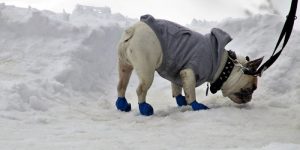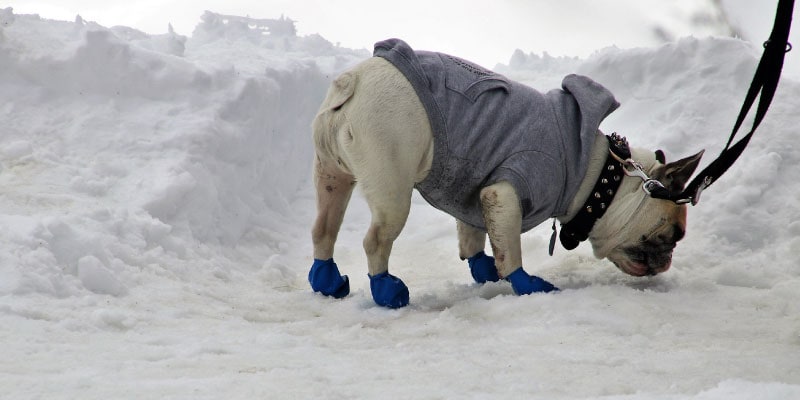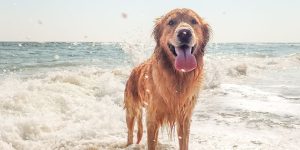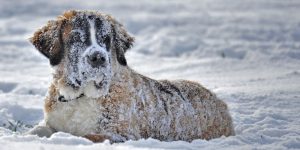How cold is too cold for your dog? Do dogs need winter coats? Here's a list of all the tips or tricks you need to know to keep your dog safe this winter.

As the leaves start to turn and the temperature drops, it’s normal to have a few questions. We put jackets and scarves on our bodies, don’t our pups deserve much the same?
In fact, the answer is a little more complicated than that. The good news is that there are some easy ways to keep your dog warm and safe this winter, no matter the breed.
1. First: know your dog breed
Before you head off to buy expensive dog boots, electric blankets, and hefty coats, do a little research on your dog breed. This may save you a lot of time and trouble.
Do you own a dog with a double coat?
This type of coat has been bred into dogs to withstand very cold temperatures thanks to a thick, coarse outer coat and an undercoat that is one to two inches deep. It’s oily and woolly to repel wetness and cold.
Double coat dogs include obvious candidates such as Siberian Huskies, German Shepherds, and Newfoundlands. But it also includes less well-known breeds such as Beagles, Border Collies, and Corgis.
These breeds will be able to withstand the cold better than most, and the trick will be keeping them cool, rather than warm.
But what about the other dog breeds? And we’re not talking about the Chihuahua and Whippets that will obviously feel the cold. Other short hair dogs such as Bull Terriers, Dalmatians, and English Bulldogs may be uncomfortable in the deep snow.
Does size matter?
Does that mean that you can throw a Beagle into a meter of snow and they’ll be fine? Well, no. A little common sense goes a long way.
Unlike Huskies, Beagles were bred to deal with the more temperate clime of Great Britain. You still get icy morning and cold winters, but rarely do you go in the minus degrees and months of snow.
As a general rule, the smaller and skinner the dog, the less it will stand the cold. But with snow, you generally always need extra protection.
A Great Dane in the UK, for example, will probably be fine with the wet winters but if you live in Sweden or Canada, they’ll need a coat. A little research goes a long way – find out where the breed comes from and what it was built to do. That will answer whether you need to get a dog coat or not.
What if I don’t know the dog breed?
Take an educated guess and then, more importantly, listen to your dog.
If every time it hits 41°f / 5°C your puppy is begging not to go outside, is lifting his paws off the ground, and has his tail between his legs… it might be time to invest in some warmer clothing and boots.
Winter dog care for puppies and elderly dogs
And on top of all this breed advice, bear in mind that no matter what type of dog you own, you should always take extra care with puppies and elderly dogs.
Even a Malamute Puppy will only be able to withstand the snow for so long, and the hardiest of labradors may struggle through joint pain at later stages of their life.
2. Make sure your dog has an ID tag and updated Microchip
If you are unsure how your dog will react to snow or icy weather, keep them on a lead.
But if you feel comfortable letting them run in the woods or dog park off lead, remember that new environments leads to new sounds and new experiences – which can spook your dog.
Make sure your recall is up to scratch, and at the very least their ID tag and Microchip is updated with the latest address details. That way a good samaritan can bring your pup home, safe and sound.
3. Get a dog coat or jumper
There are some breeds that should always wear a dog coat or jumper, even during a mild winter. If nothing else, keeping them dry not only keeps them warm but makes them easier to clean when you step back through the front door.
We’ve written aboutthe best and hardy raincoats for dogs already, but needless to say, make sure they fit well and are comfortable.
Jumpers are a little more controversial as they can cause dogs to overheat, especially if you put them on the wrong breed.
However, as a general rule of thumb, if you have a short hair breed dog, and you are putting on your coat, hat, and scarf, they may need a coat and jumper for a long walk.
4. Make them visible using lights, collars and jackets
Winter can make the days get dark early and stay dark for long, and by the time you get home, you may not be able to see much beyond your own nose.
Even if you are in the habit of walking your dog during the day, fog and haze can make the most beautiful moors hazardous to your pup.
But that doesn’t mean you have to give up off lead walks completely. An easy safety feature is simple to buy a dog light collar. This will ensure you can always keep an eye on them and know they are never far.
A light-reflective jacket, especially if you are walking your dog on busy roads, is also a must for any city-dweller.
5. Clean salt and grit from their toes
Especially important for dogs living in the city, salt and grit is not just uncomfortable if it gets stuck in between your dog’s paws, but too much salt will make your dog sick.
And if the grit gets in their toes, you just know they’ll spend an hour licking every last bit of salt.
There is little you can do about people gritting and salting the roads and the pavements, and you probably wouldn’t want them to stop for your own safety.
The solution: wash their feet or invest in boots
The solution is simple: as soon as you get home wash their paws. Some people recommend putting vaseline and other products on their feet, but you’ll still need to wash it off at the end of the walk.
If the idea of washing their feet constantly in and out of the house annoys you, you can buy some comfortable all-weather dog boots for those snowy days.
6. Antifreeze is tasty and poisonous to dogs
This is an odd warning, but one to take seriously. There’s something about the smell of anti-freeze that makes most dogs want to guzzle that down like it’s a fresh lamb on a spit.
And when is antifreeze more likely to be around the house? Winter.
Keep it in the shed, the garage, and on a high shelf and only bring it out to top up the car.
7. Keep their paws and coats longer and knot-free
If you have a non-shedding dog coat, like a poodle or an old English sheepdog, you will need to sheer them at some point during the winter. If you can, keep it longer, or invest in a coat for when it’s short.
Whatever the breed, a good rule is to always brush out old fur. This will allow a fuller coat to grow in and help the insulation. Clumpy matted fur not only takes longer to dry but restricts blood flow to the skin of the dog, making it harder for them to regulate their body heat.
8. Snow compacting between their toes
For the most part this will only affect long-haired dogs, but it’s good practice for all dog owners in snowy climates.
The hair between their toes can lead to snow compacting and ice balls, which can be painful if left unattended. Trimming your dog’s toes can help, but we’d rather simply brush off snow after a walk than risk them getting cold toes.
This is a personal preference, either solution works fine.
Any other ways of keeping my dog safe this winter?
The best thing you can do is to do your research on your dog breed. And even then, each dog has their own personality and temperament.
We know a french bulldog who loves eating snow, whilst his brother will spread flat on the floor to avoid stepping outside in cold weather.
It’s never a bad idea to keep their coats clean and tangle-free, and if in doubt, buy a simple raincoat to keep the majority of the moisture off their skin.
If in doubt, there’s plenty of indoor dog games you can play to exercise your dog for a couple of days whilst the bad weather passes.








